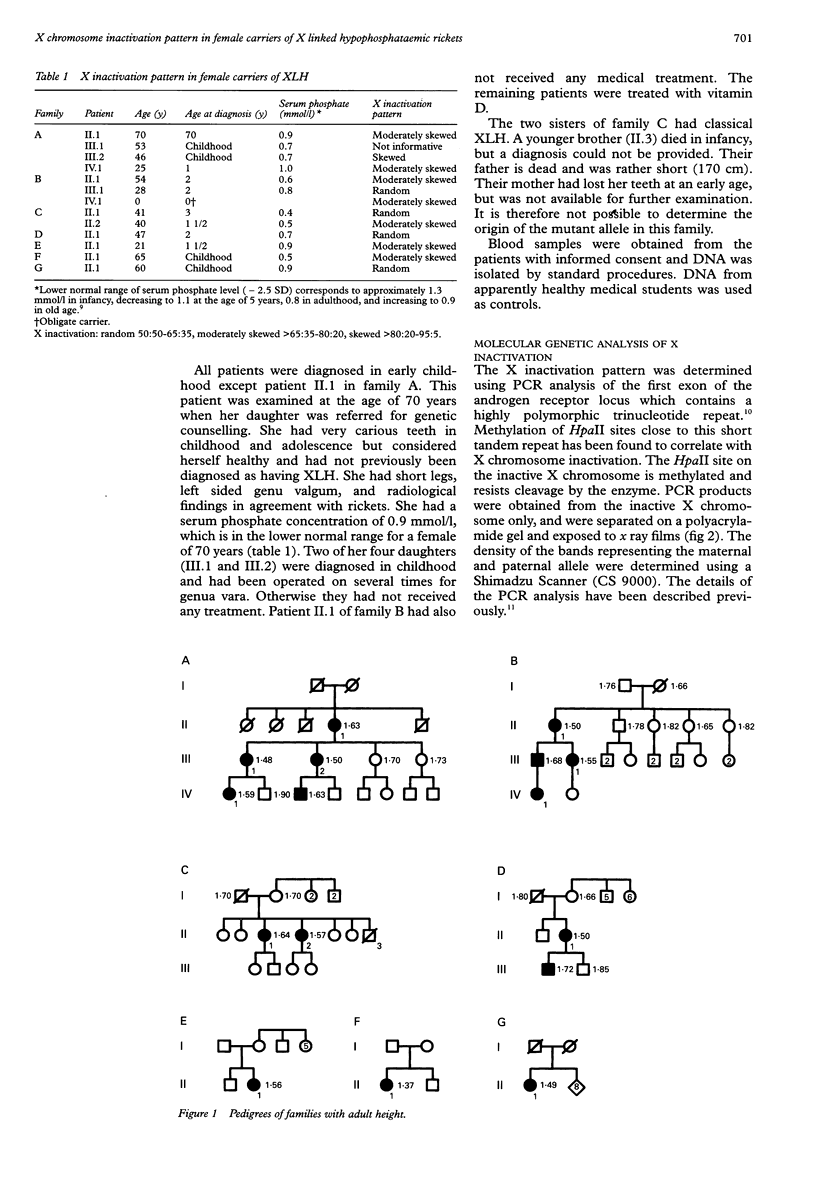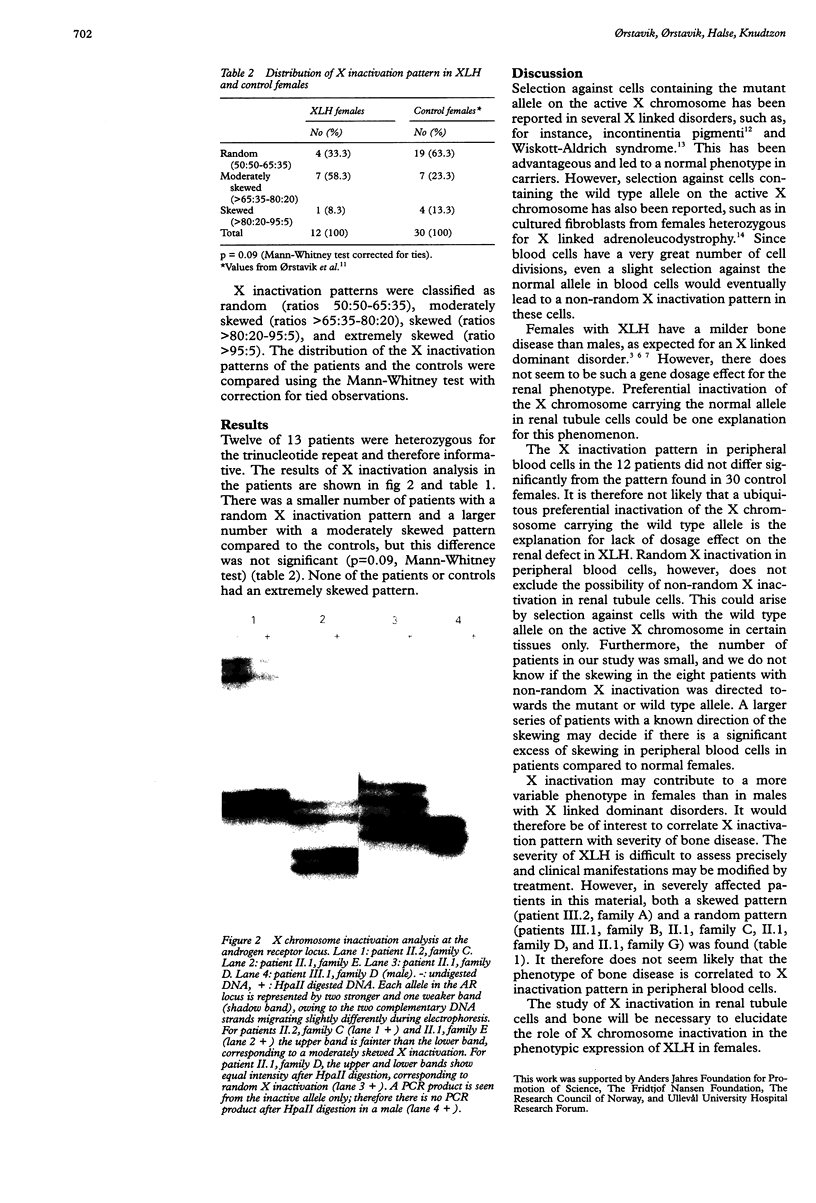Abstract
X linked hypophosphataemia (XLH) results from an abnormality of renal tubular phosphate reabsorption. The disorder is inherited as an X linked dominant trait and the gene has been mapped to Xp22.1-p22.2. A candidate gene (PEX) has recently been isolated. The most striking clinical features are growth retardation and skeletal abnormalities. As expected for X linked dominant disorders, females are less affected. However, such a gene dosage effect does not exist for renal phosphate reabsorption. Preferential X chromosome inactivation has been proposed as a possible explanation for this lack of gene dosage. We have examined the X inactivation pattern in peripheral blood cells from 12 females belonging to seven families with XLH using PCR analysis at the androgen receptor locus. The X inactivation pattern in these patients did not differ significantly from the pattern in 30 healthy females. The X inactivation pattern in peripheral blood cells does not necessarily reflect the X inactivation pattern in renal cells. However, the finding of a normal distribution of X inactivation in peripheral blood cells indicates that the similarity in the renal handling of phosphate in male and female patients is not related to a ubiquitous preferential X inactivation.
Full text
PDF



Images in this article
Selected References
These references are in PubMed. This may not be the complete list of references from this article.
- Allen R. C., Zoghbi H. Y., Moseley A. B., Rosenblatt H. M., Belmont J. W. Methylation of HpaII and HhaI sites near the polymorphic CAG repeat in the human androgen-receptor gene correlates with X chromosome inactivation. Am J Hum Genet. 1992 Dec;51(6):1229–1239. [PMC free article] [PubMed] [Google Scholar]
- BURNETT C. H., DENT C. E., HARPER C., WARLAND B. J. VITAMIN D-RESISTANT RICKETS. ANALYSIS OF TWENTY-FOUR PEDIGREES WITH HEREDITARY AND SPORADIC CASES. Am J Med. 1964 Feb;36:222–232. doi: 10.1016/0002-9343(64)90085-3. [DOI] [PubMed] [Google Scholar]
- Fearon E. R., Kohn D. B., Winkelstein J. A., Vogelstein B., Blaese R. M. Carrier detection in the Wiskott Aldrich syndrome. Blood. 1988 Nov;72(5):1735–1739. [PubMed] [Google Scholar]
- GREENBERG B. G., WINTERS R. W., GRAHAM J. B. The normal range of serum inorganic phosphorus and its utility as a discriminant in the diagnosis of congenital hypophosphatemia. J Clin Endocrinol Metab. 1960 Mar;20:364–379. doi: 10.1210/jcem-20-3-364. [DOI] [PubMed] [Google Scholar]
- LYON M. F. Gene action in the X-chromosome of the mouse (Mus musculus L.). Nature. 1961 Apr 22;190:372–373. doi: 10.1038/190372a0. [DOI] [PubMed] [Google Scholar]
- Migeon B. R., Axelman J., Jan de Beur S., Valle D., Mitchell G. A., Rosenbaum K. N. Selection against lethal alleles in females heterozygous for incontinentia pigmenti. Am J Hum Genet. 1989 Jan;44(1):100–106. [PMC free article] [PubMed] [Google Scholar]
- Migeon B. R., Moser H. W., Moser A. B., Axelman J., Sillence D., Norum R. A. Adrenoleukodystrophy: evidence for X linkage, inactivation, and selection favoring the mutant allele in heterozygous cells. Proc Natl Acad Sci U S A. 1981 Aug;78(8):5066–5070. doi: 10.1073/pnas.78.8.5066. [DOI] [PMC free article] [PubMed] [Google Scholar]
- Orstavik R. E., Tommerup N., Eiklid K., Orstavik K. H. Non-random X chromosome inactivation in an affected twin in a monozygotic twin pair discordant for Wiedemann-Beckwith syndrome. Am J Med Genet. 1995 Mar 27;56(2):210–214. doi: 10.1002/ajmg.1320560219. [DOI] [PubMed] [Google Scholar]
- Reid I. R., Hardy D. C., Murphy W. A., Teitelbaum S. L., Bergfeld M. A., Whyte M. P. X-linked hypophosphatemia: a clinical, biochemical, and histopathologic assessment of morbidity in adults. Medicine (Baltimore) 1989 Nov;68(6):336–352. [PubMed] [Google Scholar]
- Rowe P. S., Goulding J., Read A., Lehrach H., Francis F., Hanauer A., Oudet C., Biancalana V., Kooh S. W., Davies K. E. Refining the genetic map for the region flanking the X-linked hypophosphataemic rickets locus (Xp22.1-22.2). Hum Genet. 1994 Mar;93(3):291–294. doi: 10.1007/BF00212025. [DOI] [PubMed] [Google Scholar]
- Scriver C. R., Tenenhouse H. S. X-linked hypophosphataemia: a homologous phenotype in humans and mice with unusual organ-specific gene dosage. J Inherit Metab Dis. 1992;15(4):610–624. doi: 10.1007/BF01799618. [DOI] [PubMed] [Google Scholar]
- Shields E. D., Scriver C. R., Reade T., Fujiwara T. M., Morgan K., Ciampi A., Schwartz S. X-linked hypophosphatemia: the mutant gene is expressed in teeth as well as in kidney. Am J Hum Genet. 1990 Mar;46(3):434–442. [PMC free article] [PubMed] [Google Scholar]
- WINTERS R. W., GRAHAM J. B., WILLIAMS T. F., McFALLS V. W., BURNETT C. H. A genetic study of familial hypophosphatemia and vitamin D resistant rickets with a review of the literature. Medicine (Baltimore) 1958 May;37(2):97–142. doi: 10.1097/00005792-195805000-00001. [DOI] [PubMed] [Google Scholar]



